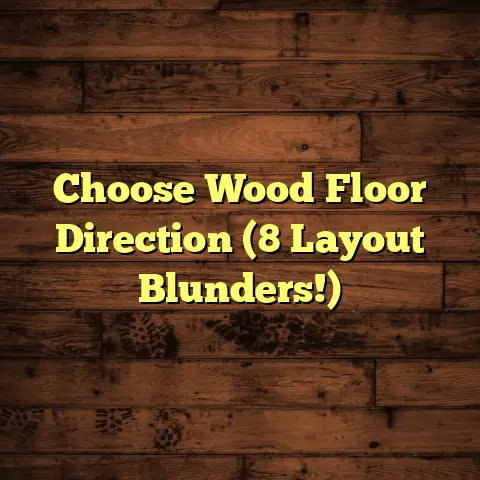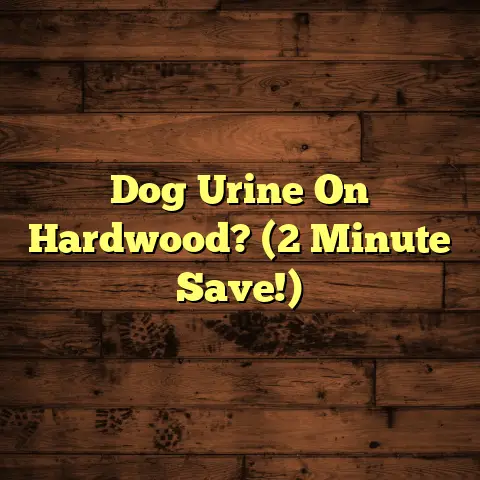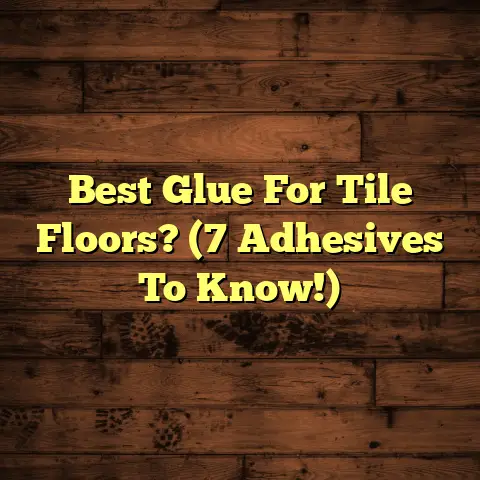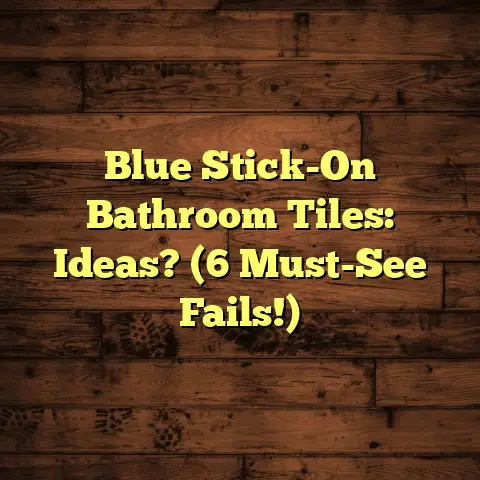What to Look For In LVP (2 Wear-Layer Musts!)
From hardwood that buckles to tile that cracks, I’ve dealt with just about every flooring nightmare you can imagine.
But there’s one flooring option that’s been consistently impressing me and my clients lately: Luxury Vinyl Plank, or LVP as we call it in the trade.
Blending Styles with Luxury Vinyl Plank (LVP)
LVP has become a real game-changer in interior design.
It’s incredibly versatile, blending seamlessly with a range of styles, from rustic farmhouse to sleek contemporary.
I’ve seen clients use it to create a warm, inviting atmosphere in their living rooms, and others have opted for a more modern, minimalist look in their kitchens.
One of the biggest advantages of LVP is its ability to mimic natural materials like hardwood and stone.
You can get the look of beautiful oak floors without the hefty price tag or the worry of water damage.
Or, achieve the elegance of slate tile without the coldness or the hassle of grout.
It really opens up a world of possibilities!
But here’s the thing: not all LVP is created equal.
The key to getting the most out of LVP, both in terms of aesthetics and longevity, is choosing the right product.
And that’s where the wear layer comes in.
The wear layer is like the bodyguard of your floor, protecting it from scratches, dents, and stains.
Choosing the right wear layer can make all the difference between a floor that looks great for years to come and one that starts to show wear and tear after just a few months.
In this article, I’m going to walk you through everything you need to know about LVP wear layers.
I’ll explain what it is, why it’s so important, and the two must-have characteristics you should prioritize when selecting LVP.
So, grab a cup of coffee, settle in, and let’s dive in!
Section 1: Understanding Luxury Vinyl Plank (LVP)
Okay, let’s start with the basics.
What is Luxury Vinyl Plank (LVP)?
Luxury Vinyl Plank (LVP) is a type of resilient flooring that’s designed to mimic the look of natural materials like hardwood, stone, and ceramic tile.
But unlike those materials, LVP is made from synthetic materials, primarily PVC (polyvinyl chloride).
This gives it several advantages, including water resistance, durability, and affordability.
LVP is typically constructed in multiple layers:
- Wear Layer: The top layer, which protects the floor from scratches, stains, and wear.
- Print Layer: A high-resolution photographic image that gives the LVP its realistic appearance.
- Core Layer: A dense, waterproof layer that provides stability and impact resistance.
- Backing Layer: The bottom layer, which provides cushioning and helps to adhere the LVP to the subfloor.
The Rise of LVP
LVP has exploded in popularity in recent years, and for good reason.
It offers a compelling combination of style, performance, and value.
I’ve seen it used in everything from residential homes to commercial spaces like offices, retail stores, and even hospitals.
Here’s why LVP is such a hit:
- Water Resistance: Unlike hardwood, LVP is completely waterproof, making it ideal for kitchens, bathrooms, and basements.
- Durability: LVP is highly resistant to scratches, dents, and stains, making it a great choice for high-traffic areas and homes with pets.
- Affordability: LVP is typically less expensive than natural materials like hardwood and stone, making it a budget-friendly option.
- Easy Installation: Many LVP products feature click-lock systems that make installation quick and easy, even for DIYers.
- Low Maintenance: LVP is easy to clean and maintain, requiring only regular sweeping and occasional mopping.
Design Options
One of the things I love most about LVP is the sheer variety of design options available.
You can find LVP in just about any color, texture, and style you can imagine.
Want the look of distressed oak? No problem.
How about the elegance of marble? You got it.
Here are just a few of the design options you’ll find:
- Wood-Look LVP: Mimics the appearance of various wood species, such as oak, maple, hickory, and walnut.
- Stone-Look LVP: Replicates the look of natural stone like slate, travertine, and marble.
- Tile-Look LVP: Offers the appearance of ceramic or porcelain tile, often with realistic grout lines.
- Wide Plank LVP: Features wider planks for a more contemporary look.
- Distressed LVP: Has a textured surface that mimics the look of aged or reclaimed wood.
With so many options to choose from, you’re sure to find an LVP that perfectly complements your style and décor.
Section 2: The Importance of the Wear Layer in LVP
Now, let’s get to the heart of the matter: the wear layer.
What is the Wear Layer?
The wear layer is the top, protective layer of an LVP plank.
Think of it as the shield that stands between your beautiful floor and the daily onslaught of foot traffic, pet claws, furniture legs, and dropped objects.
It’s typically made of a clear, durable coating, often polyurethane or a similar material.
The wear layer’s job is to resist:
- Scratches: From pets, furniture, and everyday wear.
- Stains: From spills, dirt, and grime.
- Dents: From dropped objects and heavy furniture.
- Fading: From sunlight exposure.
Without a good wear layer, your LVP floor will quickly start to show its age, with scratches, scuffs, and faded areas becoming visible.
Wear Layer Thickness
Wear layer thickness is measured in mils (thousandths of an inch).
The higher the mil rating, the thicker and more durable the wear layer.
Common wear layer thicknesses range from 6 mil to 30 mil, or even higher for commercial applications.
Here’s a general guideline:
As you can see, the thicker the wear layer, the better it will stand up to heavy use.
Two Wear-Layer Musts
When choosing LVP, there are two critical characteristics of the wear layer that you should prioritize:
- Thickness: The thicker the wear layer, the more durable the floor.
- Quality: The type of material used and the manufacturing process can significantly impact the wear layer’s performance.
In the next two sections, I’ll delve into each of these must-haves in more detail.
Section 3: Must #1 – Thickness of the Wear Layer
Let’s talk about thickness.
Industry Standards
As I mentioned earlier, wear layer thickness is measured in mils.
While there’s no single “magic number” for wear layer thickness, here are some general guidelines based on industry standards and my own experience:
- 6-8 mil: Suitable for light residential use in areas with minimal foot traffic, such as bedrooms or guest rooms.
I typically advise against this thickness for most of my clients, as it’s not very durable. - 12 mil: A good option for moderate residential use in areas like living rooms, dining rooms, and hallways.
It’s a decent compromise between price and durability. - 20 mil: Ideal for heavy residential use in areas like kitchens, bathrooms, and entryways.
It’s also suitable for light commercial applications. - 20+ mil: The best choice for high-traffic areas, homes with pets or children, and commercial spaces.
It offers the best protection against scratches, dents, and stains.
Scenarios for Thicker Wear Layers
In some situations, a thicker wear layer is absolutely essential.
Here are a few examples:
- High-Traffic Areas: If you have a busy household with lots of foot traffic, a thicker wear layer will help your floor stand up to the wear and tear.
- Homes with Pets: Pets can be tough on floors.
A thicker wear layer will provide better protection against scratches from claws and accidents. - Homes with Children: Kids can be messy and hard on floors.
A thicker wear layer will help resist spills, stains, and dents. - Commercial Spaces: Commercial spaces typically experience much higher levels of foot traffic than residential homes.
A thicker wear layer is essential for ensuring the floor’s longevity.
Expert Insights
I recently spoke with a representative from Shaw Floors, one of the leading manufacturers of LVP flooring, about the importance of wear layer thickness.
They emphasized that a thicker wear layer not only provides better protection against scratches and stains but also helps to extend the life of the floor overall.
They also noted that a thicker wear layer can improve the floor’s resistance to fading from sunlight exposure.
Section 4: Must #2 – Quality of the Wear Layer
Now, let’s talk about quality.
Types of Wear Layer Materials
While thickness is important, the type of material used in the wear layer and the manufacturing process can also significantly impact its performance.
Here are some common types of wear layer materials:
- Vinyl: A basic vinyl wear layer is the most common and affordable option.
It provides decent protection against scratches and stains, but it’s not as durable as some other options. - Enhanced Vinyl: Enhanced vinyl wear layers are treated with special coatings or additives to improve their scratch and stain resistance.
These coatings may include urethane, ceramic beads, or other proprietary materials. - Urethane: Urethane wear layers are known for their durability and resistance to scratches, stains, and fading.
They’re a good choice for high-traffic areas and homes with pets or children. - Ceramic-Reinforced: Ceramic-reinforced wear layers are infused with tiny ceramic particles to enhance their scratch resistance.
They’re one of the most durable options available.
Technologies Used in Wear Layer Manufacturing
Manufacturers use a variety of technologies to enhance the performance of wear layers.
Here are a few examples:
- UV Coating: A UV coating helps to protect the wear layer from fading caused by sunlight exposure.
- Scratch-Resistant Coating: A scratch-resistant coating helps to prevent scratches from pets, furniture, and everyday wear.
- Stain-Resistant Coating: A stain-resistant coating helps to prevent stains from spills, dirt, and grime.
- Embossing: Embossing creates a textured surface that mimics the look of natural materials like wood or stone.
It can also help to hide scratches and scuffs.
Warranty Coverage
Warranty coverage is another important factor to consider when evaluating the quality of a wear layer.
A good warranty should cover:
- Wear-Through: If the wear layer wears through to the print layer within the warranty period, the manufacturer will typically replace the flooring.
- Staining: If the wear layer stains despite proper cleaning, the manufacturer may cover the cost of cleaning or replacement.
- Fading: If the wear layer fades significantly due to sunlight exposure, the manufacturer may offer a replacement.
Be sure to read the warranty carefully before making a purchase, and ask questions if you’re unsure about any of the terms.
Section 5: Additional Features to Consider When Choosing LVP
While the wear layer is undoubtedly important, it’s not the only factor to consider when choosing LVP.
Here are a few other features to keep in mind:
- Water Resistance: While all LVP is water-resistant, some products are more waterproof than others.
If you’re installing LVP in a bathroom or basement, look for a product that’s specifically labeled as waterproof. - Installation Method: LVP is available in a variety of installation methods, including glue-down, floating, and click-lock.
Click-lock is the easiest method for DIYers, while glue-down provides the most secure and stable installation. - Core Material: The core layer of LVP provides stability and impact resistance.
Common core materials include SPC (stone plastic composite) and WPC (wood plastic composite).
SPC is generally more durable and water-resistant than WPC. - Backing Layer: The backing layer provides cushioning and helps to adhere the LVP to the subfloor.
Some LVP products have an attached underlayment for added comfort and sound absorption. - Environmental Impact: If you’re concerned about the environmental impact of your flooring, look for LVP products that are certified by organizations like FloorScore or GreenGuard.
These certifications indicate that the product has been tested for low VOC emissions.
Section 6: Maintenance and Care for LVP Flooring
Once you’ve installed your beautiful new LVP floor, it’s important to take care of it properly to extend its life and maintain its appearance.
Here are a few tips for maintaining LVP flooring:
- Sweep or Vacuum Regularly: Sweep or vacuum your LVP floor regularly to remove dirt, dust, and debris.
- Mop Occasionally: Mop your LVP floor occasionally with a pH-neutral cleaner designed specifically for vinyl floors.
- Avoid Harsh Chemicals: Avoid using harsh chemicals, abrasive cleaners, or scouring pads on your LVP floor, as they can damage the wear layer.
- Use Furniture Pads: Place furniture pads under the legs of your furniture to prevent scratches and dents.
- Clean Up Spills Immediately: Clean up spills immediately to prevent staining.
- Use Doormats: Place doormats at entrances to trap dirt and debris before they can be tracked onto your LVP floor.
Conclusion: Making an Informed Decision on LVP
Choosing the right LVP floor can be a big decision.
But by understanding the importance of the wear layer and considering the other factors I’ve discussed in this article, you can make an informed decision that will result in a beautiful, durable, and long-lasting floor.
Remember, the two must-have characteristics of the wear layer are thickness and quality.
Look for a wear layer that’s thick enough to stand up to your lifestyle and made from a durable material that’s resistant to scratches, stains, and fading.
And don’t forget to consider the warranty coverage and the manufacturer’s reputation.
With a little research and planning, you can find an LVP floor that not only enhances your home’s aesthetic but also stands the test of time.
Happy flooring!





